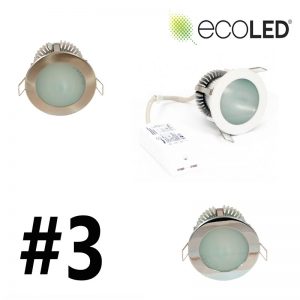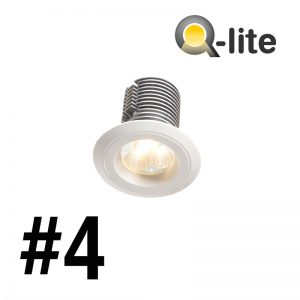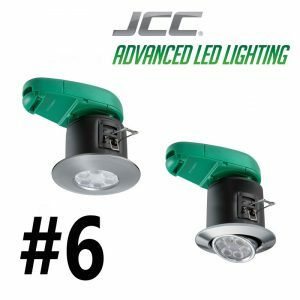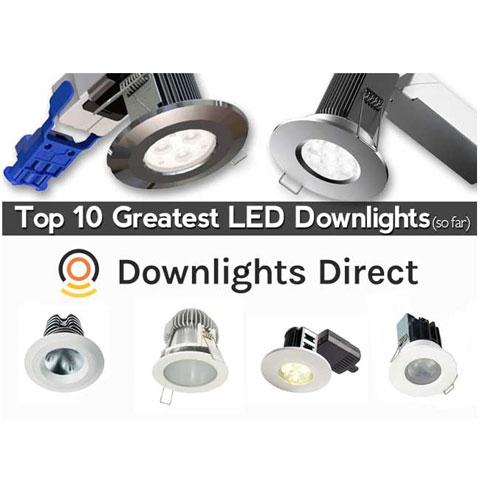Top 10 Greatest LED Downlights so Far…
The integrated LED downlight revolution began way back in 2009. While many of the original ones have come and gone, I'd like to take this moment to remember how it all started and to pay tribute to the manufactures who pioneered this technology.
An integrated LED downlight is a recessed ceiling mounted luminaire with a built-in LED light source. The LED light or chip is usually non replaceable and has an LED driver which is either directly attached to, built into the LED chip (High voltage LEDs only) or supplied with it, similar to a low voltage transformer.
They are supplied as a complete unit and are mains voltage. The downlight housing is built around the LED which provides improved airflow allowing for a brighter, longer lasting product.
The first integrated downlight I ever encountered was the Kosnic Power LED 3x3W version. When this product was first launched nobody fully understood its capabilities or potential. It appeared on a flyer and was mainly ignored.
Now six years on the market is saturated with them, with many variations to choose from. Many have come and gone over the years due to lack of demand or advances in LED technology. Some have just been re-branded and are still pretty much the same as they were.
Whilst most of the key players in the lighting industry were introducing versions of their own, some with highly innovative stand out new features and some blatant copies of the best sellers. The world’s largest lighting manufacturer Philips missed the trick on this product. Although they had their SmartSpot range which appears on this list, they’re main contribution was the TurnRound LED downlight. This was heavily over-priced, not fire rated and was non dimmable.
Perhaps the lack of demand for these ranges caused Philips to concentrate on their market leading Master LED retrofit lamps instead and miss out on this multi-million pound industry?
This top ten LED downlight list is mainly based upon quality, reliability and the sales volumes achieved by leading on-line lighting distributor: Downlights Direct. But it is mainly based upon the opinion of the 'Downlights Connoisseur' Chris Horridge.
1. Halers H2 Pro (formally EvoLED) (Launched 2010)
The Halers EvoLED did for the LED downlight industry what the iPhone did for the Smart phone industry – it put it on the map and made everyone wanted one. It has undergone many changes over the years, mainly its name and branding which I personally think was right from the start.
The Halers range now falls under the Collingwood Lighting brand name which was secretly behind Halers right from the start. The Halers brand and company was incorporated solely to promote the EvoLED brand as someone at Collingwood had the astute vision and confidence that it would achieve extremely high demand and thought it would need a dedicated team of sales staff to promote it.
If rumours are accurate, the EvoLED achieved sales of 8 million in its first year! Exceptional for just one downlight. Although there were a few issues of failures in the early days, the H2 Pro is number one on my list.
With it being both fire rated and IP65 as standard this meant it could be used anywhere, ranging from bathrooms to living rooms or it could even be used commercially. You could finally have fully matching downlights in the bathroom as you do in the living room.
With a huge selection of 6 finishes to choose from, dimmable and non-dimmable options and choices of warm white 3000K or neutral white 4000K this led to a logistical nightmare for stockists. Stocking it was difficult as there were so many variations. Common sense has finally prevailed when the H2 Pro was relaunched it became dimmable as standard and has inter-changeable bezels. Well done Collingwood Lighting!
The H2 Pro has recently (2015) been upgraded once again and is now known as the H2 Pro 550. This new version has a twist on bezel and is more compact in size at just 56mm in depth.
2. Aurora M10 DOB (Launched 2013)

After Aurora's earlier delve into the integrated LED downlight market with the I9 they went back to the drawing board and discovered a way to make it better but more importantly more reliable. By analyzing the main failures of the unreliable I9 they discovered that the weakest component of this style of fitting was the capacitor.
A capacitor is located in the LED driver and is used to convert the supply voltages (240V) into a low voltage that LEDs need. The boffins went to work and discovered a way of using high voltage (HV) LED chips that could operate on 240V, reducing any need for a capacitor and making this downlight highly reliable and cost effective.
The M10 eventually gave birth to it's own miniature versions; the M5 and M7 which can be used in combination or as stand alone products for areas that don't require a 550 lumen 50W halogen equivalent. Eventually being replaced by the even more superior Aurora MPRO.
3. EcoLED ZEP1 (Launched 2010)

Originally the EcoLED ZEP1 was the most reliable LED downlight we sold with a less than 1% failure rate. At the time this was unheard with this style of luminaire. In more recent years the failure rates have increased mainly due to a component issue with the LED driver.
In 2014 to 2015 EcoLED introduced a new model which is brighter and more compact and is proving to be back to its original 2010 /2011 form. Providing a more, bright and reliable option.
ZEP1 is fire rated as standard and available in a choice of three colour temperatures; extra warm white 2700K, warm white 3000K and cool white 4000K. The extra warm white version is still somewhat of a rarity with integrated LED downlights . Anyone who's ever installed this product has always had great things to say about it.
The standout selling feature of this downlight is the diffused glass front. It hides away the unsightly LED chip and blends effortlessly into a ceiling space. This would be my personal choice for an LED downlight as it looks great not only when it's working but also when it's not.
The ZEP1 contains a single high output COB (chip on board) Bridgelux LED chip which allows for higher lumen efficacies to be achieved of up to 76 lumens per watt. Many other brands are have since or are now adopting this style of chip. The market leading Philips master LED lamp range even incorporates it.
4. Q-Lite (now Orluna QUAD50) (Launched 2011)

The Q-Lite could have been one of the main contenders and possibly took the mantle of ‘King of the LED downlights’ but it wasn’t ready to compete at this level. Instead holding itself back for the specification only market under the Orluna Lighting brand. The sales strategy was to achieve a lower volume of sales and to maintain it's exclusivity within the market place. This is totally the opposite to most of the other players on this list who wanted to achieve the highest sales volumes.
With its combination of a relatively high lumen output of 550 lumens and wider beam angle of 46 degrees it was a great option in lighting designs as you could space the lights out further meaning fewer lights were needed. We created a video to explain this, click here to view it.
The Q-Lite was gathering momentum and was developing a great reputation within the lighting community. The high quality die cast construction, variations of bezel colours and colour temperatures made it appeal to the more higher-end lighting installers. It is now solely available under the Orluna brand and is now called the QUAD50.
5. Collingwood FireLED (Launched 2009)

Now obsolete, the Collingwood FireLED range was way ahead of its time. This downlight was at least 25% brighter than any other LED lamp on the market. It was the first fire rated-integrated LED downlight that I recall. In many ways everything else that followed was a copy.
The FireLED range was also the first LED downlight to come with a super long 7 year guarantee. This gave buyers more confidence that they were purchasing a long lasting, high quality product, especially a product that couldn’t be replaced or repaired without taking the whole thing out and rewiring it.
One of the advantages of this range was the aesthetics; it was designed from die cast aluminium and looked very good when installed. The disadvantage to it was the price, because is was more of a Bentley it was affordable to the masses. This is why Halers went away and came back with the market leader and number one on my list: the EvoLED (now H2 Pro).
6. JCC FGLED6 (formally FGLED7) (Launched 2013)

The JCC FGLED6 may have appeared higher on the list but we've only been selling since late 2014. The original version of this was the FGLED7, I didn't like the reviews or specification for it and didn't see a place for it. Looking back this may have been an error in judgement.
When it was relaunched as the FGLED6 it had some great new innovations, the main one was that it was insulation coverable. Without needing any other accessories you can lay thermal insulation directly on top.
This is one of the most complete LED downlights and best all rounders available as it has everything there is. It is very reliable and dims well with the main dimmer switches on the market such as Varilight V-Pro, Lightwave RF, Lutron and Zano controls.
There is also a more economical, lower output FGLED3 and a higher output FGLED10 version available.
7. Philips SmartSpots (Launched 2010)

The less publicised Philips Smart Spot range could have been a major contender in our list but was never made available in a fire rated version. Due to the high cost of the unit, adding an additional fire hood to make it Part B Compliant would often take it over budget and make other alternatives seem more appealing.
This range is available in the standard round design but also available in a square version. The SmartSpot range has never been that popular even though it carries the Philips brand. With a bit more effort from Philips this could have been the market leader.
Philips did also have the Zadora LED downlight but this was made up of a downlight housing and replaceable GU10 LED. The LED was the 7W Philips MasterLED which is one of the best lighting inventions of this era. The Zadora didn't have an integrated LED so it hasn't featured in the list.
8. Kosnic PowerLED (Launched 2009)

I think this was the very first integrated LED downlight, even before the Collingwood FireLED range. Although it possibly sat around in a brochure for a few months before the sales people new how to market it.
One of the main reasons this downlight never achieved huge commercial success was the logistics. When it finally started taking off in mid-2010 and got recognised for its quality and and brighter light output than a GU10 LED, Kosnic never had any in stock.
The Kosnic PowerLED range had a die cast bezel and was available in the usual 3000K warm white and also in the less popular 6500K daylight colour temperature. There was also a non-water resistant and a fully water resistant version available. This was possibly one of the main causes of the logistical problems as there were too many variants to carry good enough stocks of.
This LED downlight was so ahead of its time that it was only ever made as a non dimmable product, back in the days when LEDs couldn’t be dimmed!
9. Elan (Launched 2012)

A relatively late comer to the integrated downlight scene is the Elan. This downlight has learned from many of its predecessors and unlike many before, it has its own unique selling features. One of the key features is that the overall depth is just 60mm making it ideal for shallow ceiling voids.
It is also dimmable as standard which is now becoming the industry standard. Why stock dimmable and non-dimmable when the price difference is minimal?
The Elan also has interchangeable die cast bezels which is not only a logistical advantage but also means that if you were to install a chrome finish (for example) you could change it for white or brushed chrome. The light output of the Elan is 580 lumens, brighter than the majority of its competitors. There is also a great adjustable version of this available which costs only slightly more than the fixed version.
10. Click Scolmore Inceptor (now Incecptor Max) (Launched 2012)

Launched in 2012 and another late entry in the industry, hence one of the main reasons for its current low ranking position in the list. If this downlight had been introduced a few years earlier it could have been a more of a contender.
This is another downlight that has got a low mounting profile at just 60mm. The standout design feature for this is that it is supplied with the Click Flow connector. This connector avoids having to use junction boxes when wiring. Within this range are pre-wired connecting cables and the Hub which is a plug-in 3 out and 1 in connector block.
The Click Inceptor eventually got superseded by the brighter Inceptor Max but the best product to come out of this brand was the Inceptor Micro. At just 49mm in depth and at a competitive price of £14.15+VAT it is a very popular and reliable product, later followed by the Inceptor Nano.
A Bright Future For LED Lighting
The world of lighting is constantly changing and many of these products have been superseded by new and improved versions. Browse our latest range of LED downlights.


